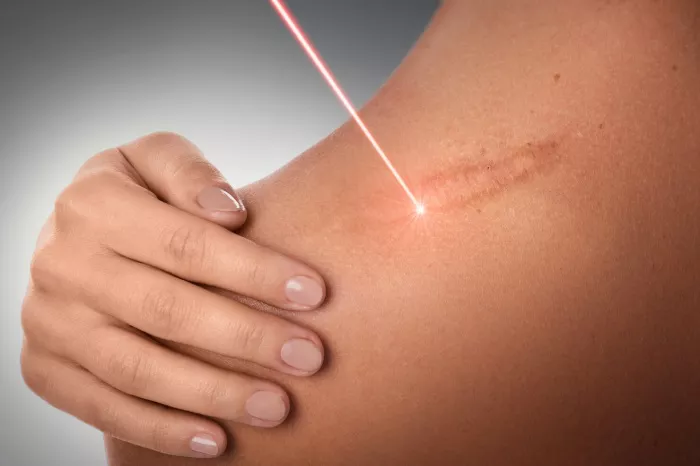Embarking on the journey of scar reduction through laser technology prompts an essential question: Is Laser Scar Removal Painful? This comprehensive exploration navigates the realms of laser scar removal, unraveling the complexities associated with the sensation experienced during treatment. As individuals seek solutions for scar improvement, understanding the nuances of pain perception, the role of different laser types, and the strategies employed for comfort becomes integral. From the initial consultation to the intricacies of laser sessions, this article delves into the multifaceted aspects that shape the comfort landscape of laser scar removal.
Understanding Pain Perception in Laser Scar Removal
The perception of pain varies among individuals, influenced by factors such as pain thresholds, skin sensitivity, and psychological considerations. Laser scar removal encompasses diverse technologies, each with distinct impacts on pain perception. Ablative lasers, involving the removal of surface layers, may induce a more pronounced sensation compared to non-ablative counterparts, which penetrate without causing surface removal. Fractional lasers, known for creating microscopic treatment zones, strike a balance between efficacy and comfort. The subjective nature of pain underscores the importance of open communication between individuals and healthcare providers, facilitating personalized approaches to optimize comfort during laser scar removal.
Ablative vs. Non-Ablative Lasers: Navigating the Comfort Spectrum
A pivotal aspect in understanding the comfort levels of laser scar removal lies in distinguishing between ablative and non-ablative lasers. Ablative lasers, exemplified by fractional CO2 lasers, work by removing thin layers of skin to promote resurfacing. The resurfacing process contributes to scar reduction but may entail a more noticeable sensation during treatment. Non-ablative lasers, such as pulsed dye lasers, penetrate the skin without causing surface removal, resulting in milder impacts on pain perception. The choice between these laser types aligns with individual scar characteristics, treatment goals, and the desired balance between comfort and efficacy.
Factors Influencing Pain Perception During Laser Scar Removal
Delving into the factors influencing pain perception during laser scar removal unveils a nuanced landscape where individual experiences intersect with technological considerations. Skin type, scar location, and the specific laser wavelength all contribute to the overall comfort or discomfort experienced during sessions. Healthcare providers play a pivotal role in assessing these factors, tailoring treatment plans to align with individual preferences and ensuring a comprehensive understanding of the potential sensations associated with laser scar removal. This collaborative approach aims to optimize comfort while maximizing the efficacy of scar reduction interventions.
Strategies for Enhancing Comfort in Laser Scar Removal
The quest for enhanced comfort during laser scar removal prompts the exploration of various strategies designed to alleviate sensations and ensure a positive treatment experience. Topical anesthetics, applied before laser sessions, serve as a common approach to minimize discomfort. Cooling devices, such as built-in cooling systems or external air devices, contribute to numbing the skin and enhancing comfort. Advanced laser technologies, evolving to prioritize patient experience, integrate features that mitigate pain perception without compromising treatment outcomes. The strategic combination of these approaches underscores the commitment to ensuring that individuals undergoing laser scar removal feel supported and comfortable throughout their transformative journey.
Navigating Pain During and After Laser Scar Removal Sessions
The actual experience of pain during laser scar removal sessions unfolds as a dynamic process, influenced by the chosen laser modality, the targeted scar type, and individual pain thresholds. Ablative lasers may induce a warm or stinging sensation, akin to sunburn, while non-ablative lasers typically result in a milder tingling or snapping feeling. Immediate post-treatment sensations often subside shortly after the session. Redness, swelling, and mild discomfort may persist temporarily, emphasizing the importance of post-treatment care to optimize the recovery process. As individuals navigate the immediate and short-term impacts of laser scar removal, healthcare providers play a crucial role in offering guidance and addressing any concerns related to pain management.
Conclusion
In conclusion, the question of whether Laser Scar Removal is Painful delves into the multifaceted landscape of individual experiences, technological differentiations, and strategies for optimizing comfort. A nuanced understanding of pain perception, the variances between ablative and non-ablative lasers, and the influencing factors allows individuals to approach laser scar removal with informed expectations. The evolving landscape of laser technologies, coupled with personalized approaches to pain management, underscores the commitment to striking the delicate balance between efficacy and comfort. As laser scar removal continues to be a transformative solution for scar reduction, prioritizing the individual’s well-being and comfort remains at the forefront of the journey towards skin revitalization and renewed confidence.
[inline_related_posts title=”You Might Be Interested In” title_align=”left” style=”list” number=”6″ align=”none” ids=”3700,3698,3696″ by=”categories” orderby=”rand” order=”DESC” hide_thumb=”no” thumb_right=”no” views=”no” date=”yes” grid_columns=”2″ post_type=”” tax=””]

































